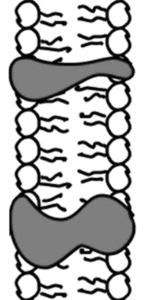My last post explored major influences on cellular activity. For a deeper dive on the subject, I read Dr. Candace B. Pert’s book Molecules of Emotion: The Science Behind Mind-Body Medicine. It chronicles a distinguished career devoted to exploring protein receptor molecules while providing a behind-the-scenes look at the interpersonal and organizational dynamics of high-stakes scientific research.
 As noted in my last post, protein receptor molecules (a.k.a., Integral Membrane Proteins or IMPs) dot the landscape of each cellular membrane. They bend and change shape in response to chemical and electromagnetic forces, and bind selectively with specific configurations of molecules called ligands. Once binding takes place, the cell may initiate one or more processes – e.g., manufacturing proteins based on its DNA blueprints, opening or closing ion channels, adding or subtracting chemical groups, or initiating cellular division. Think of it this way: If cells are the “engines” and receptor IMPs the “buttons,” then ligands are the “fingers” that push the “buttons.”
As noted in my last post, protein receptor molecules (a.k.a., Integral Membrane Proteins or IMPs) dot the landscape of each cellular membrane. They bend and change shape in response to chemical and electromagnetic forces, and bind selectively with specific configurations of molecules called ligands. Once binding takes place, the cell may initiate one or more processes – e.g., manufacturing proteins based on its DNA blueprints, opening or closing ion channels, adding or subtracting chemical groups, or initiating cellular division. Think of it this way: If cells are the “engines” and receptor IMPs the “buttons,” then ligands are the “fingers” that push the “buttons.”
There are three broad types of ligands: neurotransmitters, steroids, and peptides (e.g., hormones, growth factors, interleukins, cytokines). They are messengers that carry (or block) information transfer to the cells. Agonists attach to receptors and create cellular change. Antagonists bind to receptors and block the associated cellular activity.
Dr. Pert cracked the field wide open with her discovery of the opiate receptor, an IMP that binds to endorphins as well as man-made opiates. Her methodology provided the key to identifying a vast array of receptors. Moreover, it turned out that this intercellular communications construct within the brain was far more active than chemical signaling across synapses, perhaps by as much as fifty-fold.
The core limbic system (amygdala, hippocampus, and limbic cortex) contains 85-95% of the various neuropeptide receptors. It’s the part of the brain that is most closely associated with emotions. This finding contributed to Dr. Pert’s assertion that biochemicals serve as the molecular underpinning of what we experience as feelings, sensations, thoughts, and drives – in other words, they are the “molecules of emotion.”
 Neuropeptide receptors were also found all along the spine, with the highest concentrations associated with processing of sensory data (visual, auditory, smell, taste, touch). Most, if not all, were discovered to alter mood states. They were also found in the other major systems in the body. In fact, a massive amount of communication takes place throughout the body through neuropeptides (which should just be called peptides as they’re not confined to the brain!). The information exchange constitutes a rich language of relatedness, cooperation, interdependence, and synergy… and our brains are in on the conversation.
Neuropeptide receptors were also found all along the spine, with the highest concentrations associated with processing of sensory data (visual, auditory, smell, taste, touch). Most, if not all, were discovered to alter mood states. They were also found in the other major systems in the body. In fact, a massive amount of communication takes place throughout the body through neuropeptides (which should just be called peptides as they’re not confined to the brain!). The information exchange constitutes a rich language of relatedness, cooperation, interdependence, and synergy… and our brains are in on the conversation.
It turns out that we realize an optimal state of health when the information flow is rapid, unimpeded, and aligned with the body’s natural design. We threaten our well-being when we disrupt that flow. A few case studies illustrate the point:
When an excess of ligands flood the system, the associated receptors desensitize. If the surplus reflects a chronic condition, they’ll shrink and grow fewer in number. For example, eating processed foods and sugars causes the pancreas to secrete large amounts of insulin to promote fat storage in cells. When flooded with insulin, the receptors stop responding to the messaging, causing elevated levels of blood sugar and a host of associated maladies.
When we repress intense feeling (e.g., anger, grief), we disrupt the normal flow of neuropeptides. When these blocked emotions find release, the internal pathways clear, and we experience an influx of energy. This phenomenon explains why happy people are more resistant to disease than those who are chronically depressed or tightly-wound.
We can take advantage of the mind-body connection to produce positive health outcomes. Changes in the rate and depth of breathing produce changes in the quantity and kinds of peptides released from the brain, and vice versa. Biofeedback techniques have been used successfully to control blood circulation, heart rate, pain… even the stickiness of immune cells.
These findings suggest that the mind and body should be treated as a whole, and that proper modulation of the neuropeptide communications network could vastly improve our health. As Dr. Pert says:
“I can no longer act like a dumb machine and wait to be fixed by a mechanic. Now I have the potential to consciously intervene in the system myself, to take an active role in my own healing. I’m both more powerful and more responsible for creating the health I experience.”